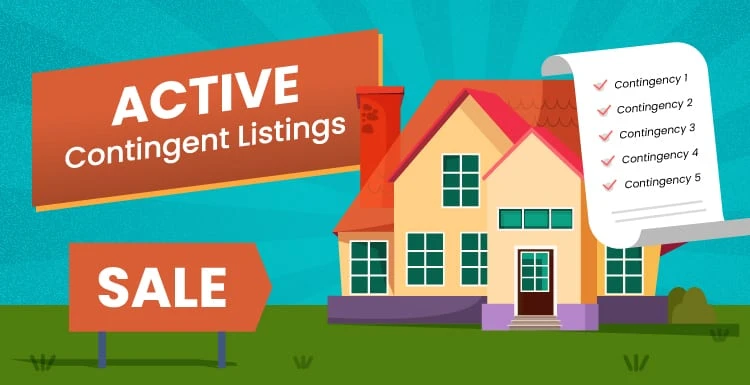If you’ve been searching for a home, you’ve probably come across a few different listing statuses, like Active, Contingent, Pending, or Sold.
When you find a property you like and decide to make an offer, it’s essential to know what different listing statuses mean. One that can be particularly confusing is the “Active Contingent” status. Can you still schedule a showing?
Is it still okay to make an offer? Is it still on the market or not? To fully understand what Active Contingent means for you, the potential home buyer, let’s look at what each part of this phrase means in real estate.
What is Active Contingent?
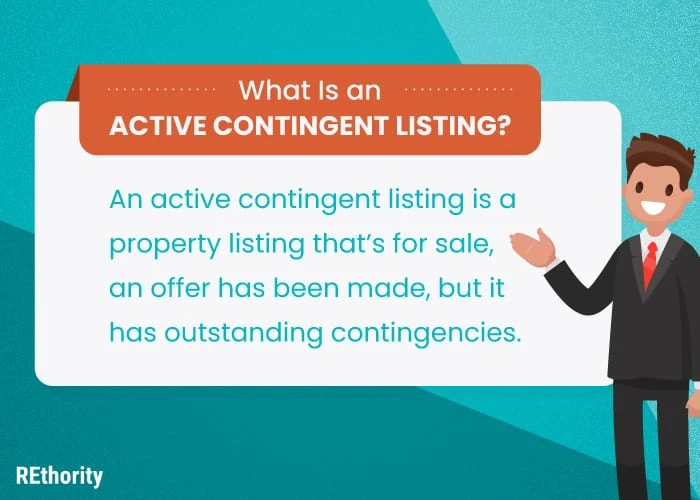
An Active listing means the listing is still technically up for sale. No buyer has gone any further in the process than possibly making an initial offer, and no offers have yet been accepted.
When you see an active listing, you can still make an offer on it. In your home search, finding a listing you like that is active is exactly what you want. When you look at an active listing, you’ll know:
- The seller may have received offers but has not yet accepted any.
- You are free to schedule a showing and make an offer on the property
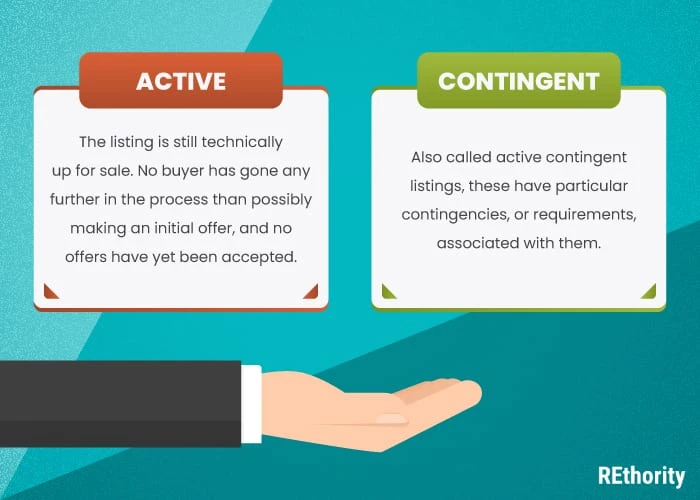
Contingent listings, also called active contingent listings, have particular contingencies, or requirements, associated with them.
They are still active listings, but they are not the same thing as active listings because the seller has:
- I received and accepted an offer from an interested buyer
- I am now just waiting to make sure any contingencies—the requirements for the sale to go through—will be met before the listing status changes to Pending or Under Agreement before being officially sold.
When the Active Contingent Status Applies
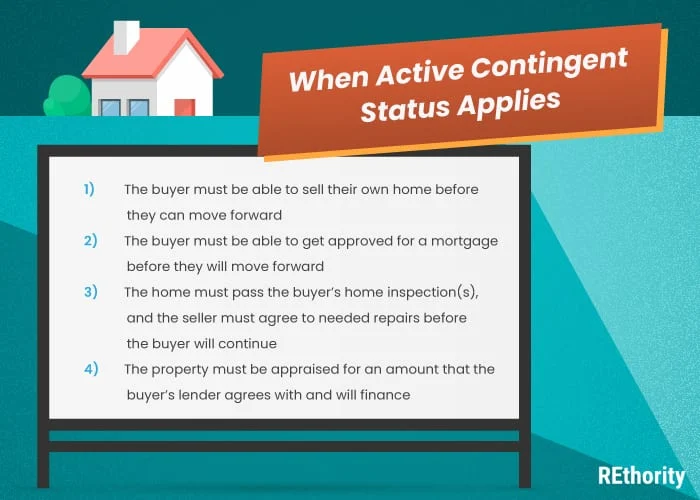
Which houses are listed under active contingent status? How do you know when this listing status applies, or what it means for you as a buyer?
The active contingent status applies only to homes and properties where the seller has received and accepted an offer that is hinging on one or more requirements or contingencies.
These must be met before they will agree to sell the home, or before the buyer will move forward with their offer. Those contingencies could be just about anything, but they are usually related to one of the following:
- The buyer must be able to sell their own home before they can move forward
- The buyer must be able to get approved for a mortgage before they will move forward
- The home must pass the buyer’s home inspection(s), and the seller must agree to needed repairs before the buyer will continue
- The property must be appraised for an amount that the buyer’s lender agrees with and will finance
After a buyer (or seller) meets the contingency requirements, the home will move from an active contingent listing status to “pending.” Let’s look at how the pending status is different from the active contingent.
Active Contingent vs. Pending Listings
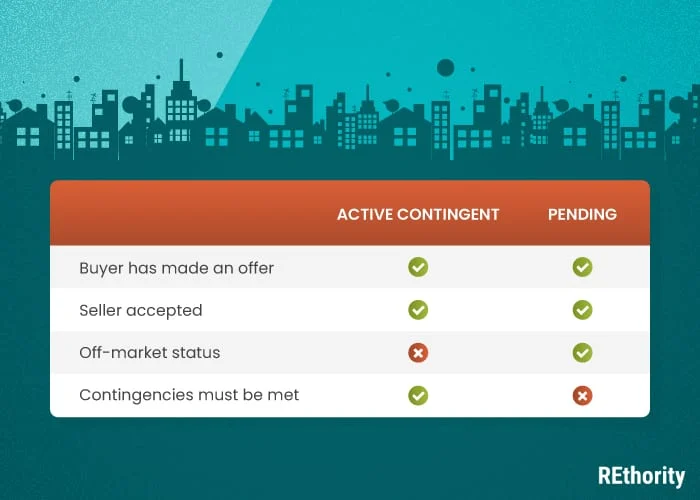
Pending, or Under Agreement (listed as UAG on the MLS), listings are different from active contingent listings because this status indicates that the buyer has made an offer.
The seller has accepted it (all contingencies, if there were any, have been met). And both parties are taking steps to move through the closing process.
Pending is considered an off-market status, meaning the home is no longer active on the MLS. This means the seller is taking care of any repairs, appraisals, and home inspections and ensuring they’re clear to move into the new home once the listed property is sold.
The buyer will be working with their lender to get a mortgage and taking care of the sale of their own current home, if applicable.
With pending listings that are under agreement, the property hasn’t technically been sold yet, but it’s very close. It is almost certainly going to end in the buyer’s possession, barring any unforeseen circumstances with the buyer or seller.
It is rare for a pending listing to go back on the market. The active contingent listing status may apply for one week up to about three weeks. It can take longer, but usually contingencies in the contract can be met or satisfied by then.
What If Contingencies Can’t Be Met?
It’s relatively uncommon, but sometimes, the contract contingencies for a property that is up for sale may not be able to be met by one or both parties.
If that happens, the home’s status will change back to active. This opens it up to new offers and takes the old, accepted offer from the buyer off the table.
What can go wrong with contract contingencies, causing them not to be met? It depends on what the contingencies are, but some of the more common reasons are:
- The buyer couldn’t get approved for a mortgage or other financing options (bad income-to-debt ratio, low credit score, past liens against them)
- The buyer submitted offers on more than one home, and the other was accepted first
- The buyer’s home inspection revealed problems they didn’t know about or that the seller refuses to fix after negotiation
- The property appraisal was too low, meaning the home is priced at a higher amount than the buyer’s lender will offer to finance for them
Overview of Home Listing Statuses
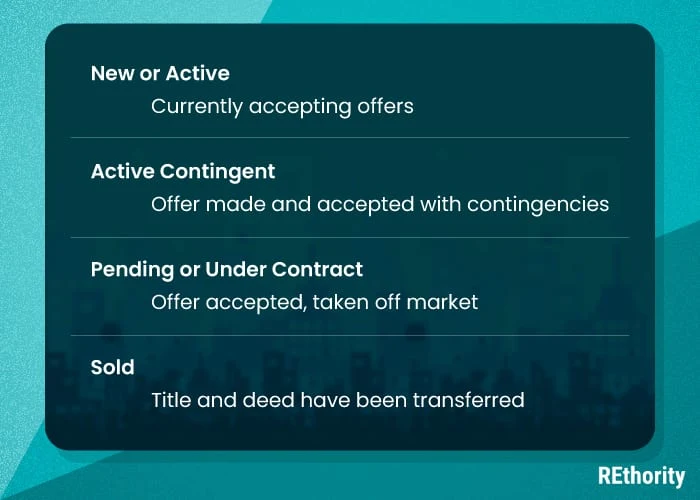
In general, most MLS property listings go through the following statuses as they move toward closing:
New or Active
A new (3 days or less on the market) or active listing shows anyone browsing MLS listings that this property is up for sale, the seller is accepting offers, and no current offers have been accepted yet.
This is the status to look for if you’re starting your home search because it provides the clearest path to closing.
Active Contingent
An active contingent listing shows anyone looking at MLS listings that while the property is not yet pending, a buyer has made an offer and the seller has accepted it.
They have now entered into a binding contract that is ready to go into effect if a few contingencies (financing, inspections, repairs, etc.) can be met first.
Offers may be able to be submitted at this stage, but in some cases, the seller will no longer accept offers. We talk more about this below.
Pending or Under Agreement
Once the contingencies on a listed property are met, the contract will move ahead as planned, and the buyer will work to get their financing in place while the seller fulfills any repairs that may have been negotiated.
The home no longer accumulates “Days on Market” (DOM) under this status. Unless something serious happens during this phase, the home will not likely be back on the market.
Sold
Once the buyer has the title and deed and ownership has officially been transferred, the listing status changes to sold. It is off the market until or unless the new owner decides to list the home for sale later.
Can You Still Make an Offer on Active Contingent Listings?
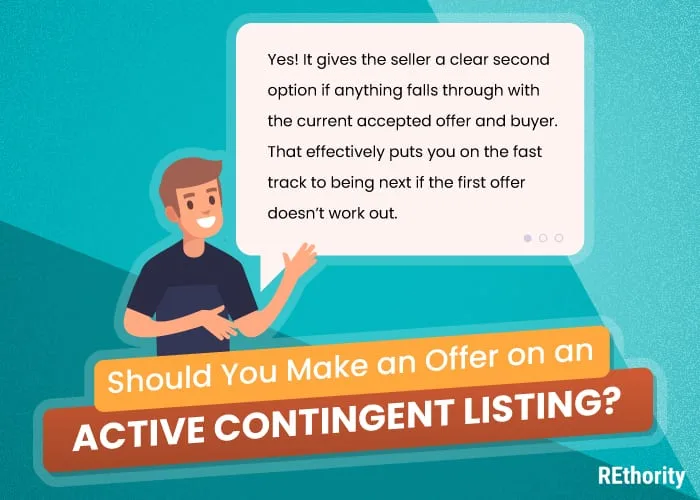
If contingent listings are still considered active, can you still make an offer on one? Unless the listing specifies that the seller is no longer accepting offers on the listing, you can still make an offer and schedule a showing for an active contingent listing.
Realtor Brendan O’Dowell encourages his clients to make an offer on active contingent listings they’re truly interested in for one reason:
It gives the seller a clear second option if anything falls through with the current accepted offer and buyer. That effectively puts you on the fast track to being next if the first offer doesn’t work out.
Remember what you’re doing when you make an offer on an active contingent listing, though. It doesn’t mean you’re likely to purchase the home, and it’s not the same thing as placing an offer on an active listing.
Active contingent listings already have an accepted offer on the table and will move to pending status as soon as those contingencies are met.
Keep watching any active contingent listing you’re interested in to see if it moves back to active status. This will happen if the buyer or seller doesn’t meet the contract contingencies and the buyer’s accepted offer is no longer on the table.
If you’re interested in a listing that is active-contingent, don’t give up just yet. You can always submit an offer if the seller’s real estate agent is open to it and be next in line if things fall through.
Keep checking in on the listing status to see if it goes back to active status—opening it up for new offers—or to see if it moves forward to pending or sold status.
Is An Active Contingent Listing Worth Looking At?
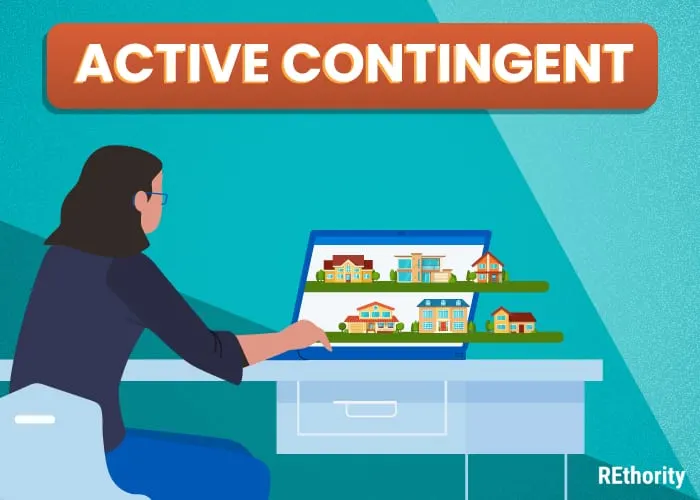
With these things in mind, what’s the overall recommendation when you come across an active contingent listing you’re interested in?
It depends on how much you like the property and how quickly you’d like to close. If you love the property and you’re not in a hurry, there’s no reason to shy away from an active contingent listing that is still accepting offers and offering showings.
Just know that if you make an offer and it is later accepted, it is a legally binding contract. Make sure you’re not making offers on multiple properties for this reason.
Even if the active contingent listing you’re interested in isn’t accepting new offers and the seller’s agent won’t be showing the home unless the status changes, it may still be worth keeping an eye on.
Things do change in the world of real estate transactions, and sometimes contracts fall through. If it’s the home of your dreams, you won’t mind waiting a little while to see if the other offer’s contingencies can be met.

